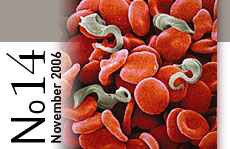 | |

 The first achievement of the DNDi-Kitasato project was the establishment of an in vitro assay with trypanosomes to screen compounds for their capacity to kill the parasites. To acquire the necessary scientific know-how, a researcher from the Kitasato Research Center for Tropical Diseases was trained at the Swiss Tropical Institute (STI). Upon her return she tried to establish the assay in her laboratory, but this was not as easy as expected. The standard strain necessary for the assay was not available in Japan; importing one from STI took several months and required tons of paper work. When some reference compounds were screened, there was a yawning chasm between the results obtained at Kitasato and those from STI. Adjusting strains to the Japanese environment was just as difficult as it is for Europeans to adjust to Japanese culture!
The first achievement of the DNDi-Kitasato project was the establishment of an in vitro assay with trypanosomes to screen compounds for their capacity to kill the parasites. To acquire the necessary scientific know-how, a researcher from the Kitasato Research Center for Tropical Diseases was trained at the Swiss Tropical Institute (STI). Upon her return she tried to establish the assay in her laboratory, but this was not as easy as expected. The standard strain necessary for the assay was not available in Japan; importing one from STI took several months and required tons of paper work. When some reference compounds were screened, there was a yawning chasm between the results obtained at Kitasato and those from STI. Adjusting strains to the Japanese environment was just as difficult as it is for Europeans to adjust to Japanese culture!After months of repeated trial and error, the researchers finally established the assay called a long incubation-low inoculation test (LILIT). In this assay, pre-diluted test samples and Trypanosoma parasites are incubated for 72 hours. After incubation, the anti-trypanosomal activity of each sample is evaluated by a fluorometric assay. Effective compounds are tested for toxicity, and only compounds that are safe and effective will be evaluated further. The goal is to find a compound that is effective in an animal model of sleeping sickness.
By now, almost 10,000 samples have been screened and a few of them have been found highly active against the target parasite. For the coming years, DNDi and Kitasato are planning to proceed with the identified hits to conduct in vivo screening and lead compound optimization in the hope of finding a new treatment for Human African Trypanosomiasis.
Fumiko Hirabayashi
DNDi Liaison Japan
The purpose of DNDi’s TR inhibitors programme, performed at the University of Dundee under the supervision of Prof Alan Fairlamb, is to identify new drug-like molecules through high throughput screening against trypanothione reductase. The initial phase allowed the identification of promising lead chemical structures active against the target enzyme. In the next phase, medicinal chemistry will continue to obtain new chemical analogues with higher selectivity and potency against the enzyme.
Denis Martin
Project Manager DNDi

In 2005, DNDi initiated an exploratory project to identify promising drug candidates among new and old nitroimidazoles, a class of compounds that have previously shown good activity against trypanosomes. The best known trypanosomal drug candidate in this class is megazol, whose development was abandoned for reasons of toxicity, in particular mutagenicity, a known possibility in this chemical family. However, other members of this family include metronidazole, a widely used antibiotic, indicating that it is possible to select compounds with a good activity/toxicity profile in this class.
DNDi set out to identify compounds in this family with potential anti-trypanosomal activity through a systematic review of past and ongoing research activities through literature and patents searches, and consultations of involved scientists. Over 500 compounds of interest were identified from at least 15 different sources in both academia and the pharmaceutical industry. These included old drug candidates in development in the ‘80s then forgotten, as well as new drug candidates in development or on the market against other diseases, e.g., TB, giardiasis, amoebiasis. To identify and prioritise possible drug candidates for HAT, the trypanocidal activity of these compounds is being (re)evaluated in in vitro and in vivo disease models, as well as in genetic toxicity assays. Other relevant chemical, biological and pharmacological data are being compiled from literature and company source data.
Based on initial data collected, this “compound-mining” effort is expected to generate one or more candidates for further development. In the best-case scenario, this could be a drug candidate to take through pre-clinical development to be ready for clinical trials in the next 2 years, which could present a significant shortcut in the development process.
Els Torreele
Project Manager DNDi
Cysteine proteases are a family of enzymes that degrade specific proteins both as part of the normal turnover of proteins in parasites and as part of their invasive armoury for attacking the host. Jim McKerrow and his team at the UCSF have taken two different approaches to validate these enzymes as drug targets in T. brucei, the causative agent of human African sleeping sickness.
Knowing that cysteine proteases are a valid drug target, DNDi is now supporting the team in identifying potent enzyme inhibitors that might become better drugs in the fight against the disease.
Rob Don
Project Manager DNDi
Editor: Ann-Marie Sevcsik - Tel: +41 22 906 9230 - Fax: +41 22 906 9231 - www.dndi.org